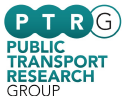Context-Sensitive Urban Transportation Design in West Philadelphia, Pennsylvania
Document Type
Journal Article
Publication Date
2006
Subject Area
land use - planning, mode - bus, mode - mass transit, mode - pedestrian, mode - rail, mode - tram/light rail, operations - capacity, organisation - management, place - urban, policy - parking
Keywords
Walking, Urban transportation, Urban goods movement, University of Pennsylvania, Transportation planning, Transit, Road transportation, Railroad commuter service, Public transit, Public private partnerships, Planning and design, Philadelphia (Pennsylvania), Parking capacity, Parking, Older cities, Mass transit, Local transit, Light rail transit, Lessons learned, Intracity transportation, Intracity bus transportation, Highway transportation, Design engineering, Cycling, Context sensitive design, Commuter rail, Campus transportation, Bus transit, Bicycling, Access management (highways), Access control (Transportation)
Abstract
The University of Pennsylvania is located in Philadelphia, Pennsylvania. Activities within the campus are supported by a host of transportation modes: private automobile, commercial vehicles, public transportation (including bus, light rail, heavy rail, and commuter rail), bicycling, and walking. In an effort to enhance the overall functioning of the transportation system in the campus area, the university has partnered with the City of Philadelphia to improve the design and operation of facilities. This paper describes those efforts, emphasizing the jurisdictional and institutional challenges. The principal objectives of the campus redesign are to increase pedestrian and bicycle safety, to upgrade transit image and performance, to maintain or increase vehicular capacity, and to accommodate the reliable movement of goods. The achievement of these objectives is complicated by several issues. The campus is traversed by State Highway 3, portions of which were designed to standards that are inconsistent with the campus goals. Design and operational considerations are influenced by the access needs of the university hospitals. Institutionally, challenges arise from within the university community, particularly on questions of parking, and from within the public agencies, with regard to modern traffic engineering practices. Efforts to achieve the transportation goals can be considered a work in progress. Several positive design and operational upgrades have been successfully implemented; and these, in turn, have established new acceptable design criteria. Other design projects remain in the evaluation phase. Several policy actions or statements require attention. The lessons learned and technical standards developed are transferable to other older cities throughout North America.
Recommended Citation
Casello, Jeffrey, Wright, Robert, Vuchic, Vukan, (2006). Context-Sensitive Urban Transportation Design in West Philadelphia, Pennsylvania. Transportation Research Record: Journal of the Transportation Research Board, 1956, pp 165-174.


